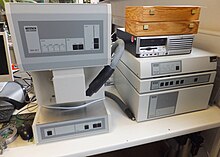Dynamic mechanical analysis
The dynamic mechanical analysis (DMA) is a thermal method to physical properties of plastics to be determined.
principle
The dynamic mechanical analysis subjects the sample to be examined to a sinusoidal mechanical load that changes over time, depending on the temperature . This causes the sample to deform with the same period. The force amplitude, the deformation amplitude and the phase shift Δ between the force and the deformation signal are measured .
The result of the dynamic mechanical analysis is the complex module of the sample. The prerequisite for this is that the sample is in no way loaded outside the linear elastic range ( Hooke's range ).

statement
There are three fundamentally different behaviors of the sample:
- Purely elastic samples react without delay to the applied force, the phase angle = 0. They oscillate without loss.
- Purely viscous samples reach their maximum deformation when the force passes through zero. The phase angle for them is therefore (90 °). They completely convert the excitation energy into heat.
- Viscoelastic materials are characterized by the fact that the deformation of the sample follows the acting force with a certain delay. The following therefore applies to the phase angle Δ . The greater the phase angle, the more pronounced is the attenuation of the vibration.
application
The DMA allows u. a. the determination of:
- viscoelastic material properties, for example modulus and the loss factor tan ( )
- Temperatures that characterize the viscoelastic behavior,
- damping
- especially the glass transition temperature , for which DMA is the most sensitive method
- the hardening behavior of resins
- the frequency-dependent mechanical behavior of materials
- Determination of the creep and relaxation processes at either constant force or constant deformation
The DMA can be used in various measurement arrangements. Common measurement arrangements include tensile, 3-point bending and compression arrangements.
See also
Web links
- Structure and functionality of a DMA from Netzsch [1]
- Areas of application DMA at the Fraunhofer Institute LBF [2]
- Test execution of a DMA measurement on PET [3]




